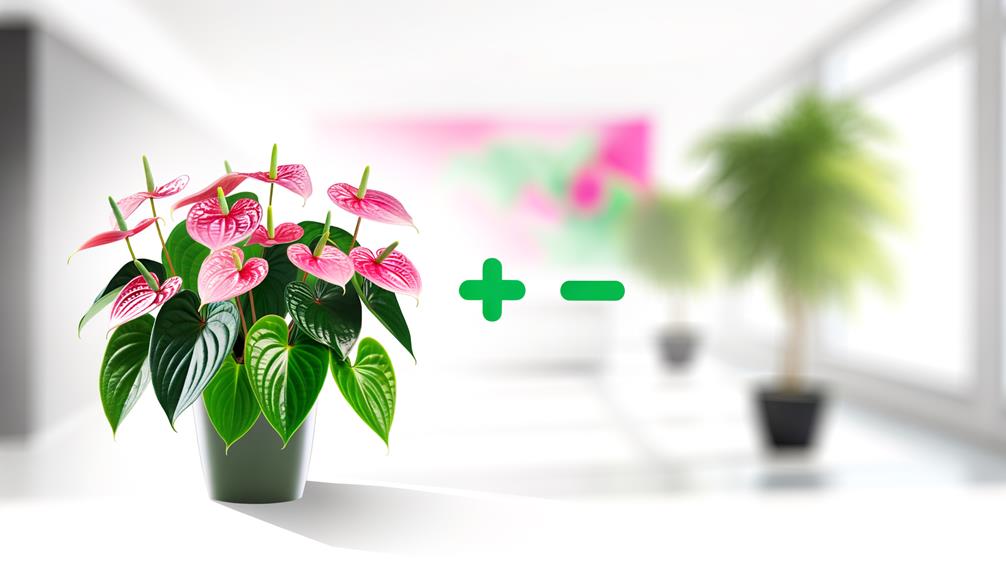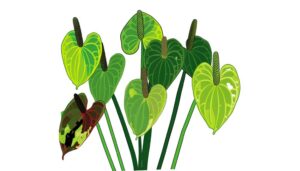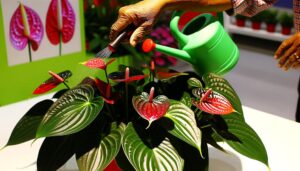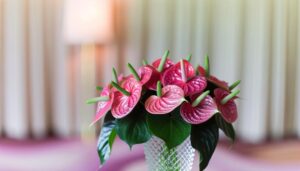Essential Tips for Thriving Anthurium Pink Dragon Plants
For thriving Anthurium Pink Dragon plants, use a well-draining mix of orchid bark, peat moss, and perlite, aiming for a pH of 5.5-6.5. Place them in bright, indirect light, avoiding direct sunlight to prevent leaf scorch.
Water when the top inch of soil is dry using room temperature, distilled water, and ensure good drainage. Maintain temperatures between 65°F and 80°F with 60-80% humidity.
Fertilize with a balanced, water-soluble fertilizer, like 20-20-20, every 6-8 weeks, diluting to half-strength. Adjust care routines seasonally and monitor closely for best growth.
Keep exploring to master their care essentials.

Key Takeaways
- Use well-draining soil with orchid bark, peat moss, and perlite for optimal aeration.
- Provide bright, indirect light and avoid direct sunlight to prevent leaf scorch.
- Water when the top inch of soil is dry, using room temperature distilled water.
- Maintain temperatures between 65°F and 80°F, with humidity levels of 60-80%.
- Fertilize with a diluted 20-20-20 NPK formulation every 6-8 weeks during the growing season.
Choosing the Right Soil
When selecting soil for your Anthurium Pink Dragon, go for a well-draining mix enriched with organic matter to promote peak root health. A combination of orchid bark, peat moss, and perlite will guarantee adequate aeration and moisture retention.
Aim for a pH range between 5.5 and 6.5, as slightly acidic conditions facilitate nutrient uptake. Avoid dense, compacted soils that can result in root rot. Instead, prioritize substrates that imitate the plant's natural epiphytic environment. Adding charcoal can assist with toxin absorption and enhance soil structure.
Watering should be adjusted based on soil moisture levels; overwatering is a common pitfall. Regularly examine and refresh the soil to preserve its beneficial properties, supporting your Anthurium's robust growth and vibrant blooms.
Optimal Light Conditions
Ensuring your Anthurium Pink Dragon receives bright, indirect light is essential for its health and vibrant foliage. Direct sunlight can scorch the leaves, while insufficient light hinders its growth. Place your plant in a location where it gets filtered light or dappled shade.
For best photosynthesis and pigmentation, follow these tips:
- North or East-facing windows: These provide consistent, gentle light without the intensity of direct sun.
- Sheer curtains: Use them to diffuse strong sunlight from South or West-facing windows, minimizing leaf burn.
- Artificial grow lights: If natural light is inadequate, install full-spectrum LED grow lights to simulate ideal conditions.
Monitor your plant's response and adjust its placement to maintain a balance between light intensity and duration.
Proper Watering Techniques
Proper watering techniques are crucial to prevent root rot and promote the healthy growth of your Anthurium Pink Dragon. Water your plant when the top inch of the potting mix feels dry to the touch.
Use room temperature, distilled water to avoid chlorine and fluoride, which can harm the roots. Make sure the pot has drainage holes to prevent waterlogging. Water thoroughly until excess drains out, then discard any water collected in the saucer.
Avoid misting the foliage; instead, focus on maintaining consistent soil moisture. Overwatering can suffocate roots, leading to fungal infections.
Monitor the soil and adjust your watering frequency according to seasonal changes, as Anthuriums require less water during their dormant phase in winter.
Ideal Temperature and Humidity
Maintaining ideal temperature and humidity levels is essential for the flourishing of your Anthurium Pink Dragon, as these conditions mimic its natural tropical habitat. Aim for a consistent ambient temperature between 65°F and 80°F to optimize metabolic functions and physiological processes. Low temperatures can stress the plant, while excessive heat can cause dehydration.
For humidity, aim to maintain levels around 60-80%. Insufficient humidity leads to desiccation of foliage and impaired growth.
- Use a hygrometer to monitor humidity levels.
- Employ a humidifier or pebble tray to increase humidity.
- Mist the leaves regularly to replicate natural moisture.
Fertilizing Your Anthurium
For ideal growth, fertilize your Anthurium Pink Dragon with a balanced, water-soluble fertilizer every 6-8 weeks during the growing season. Opt for a 20-20-20 NPK (nitrogen-phosphorus-potassium) formulation to guarantee your plant receives all essential macronutrients. Dilute the fertilizer to half-strength to prevent root burn and nutrient overload.
Apply the solution directly to the soil, avoiding foliage contact to minimize the risk of leaf scorch. Monitor the plant's response to fertilization closely—yellowing leaves can indicate nutrient deficiencies. During the dormant winter months, reduce fertilization frequency to once every 10-12 weeks.
Always water the plant thoroughly before and after applying fertilizer to enhance nutrient absorption and prevent root damage. Your attentive care will yield lush, vibrant Anthurium Pink Dragons.
Managing Pests and Diseases
While providing nutrients promotes robust growth, it's equally important to protect your Anthurium Pink Dragon from common pests and diseases that can hinder its health. Regularly inspect your plant for signs of infestation or disease. Aphids, mealybugs, and spider mites are frequent culprits.
Aphids excrete a sticky substance called honeydew, which can lead to sooty mold. Use insecticidal soap or neem oil for control.
Mealybugs appear as white, cottony masses on leaves. Remove them manually with a cotton swab dipped in isopropyl alcohol.
Spider Mites are tiny pests that create webbing and can cause yellowing. Increase humidity and use miticides if necessary.
Early detection and intervention are essential to maintaining plant health.
Conclusion
By mastering these essential tips, you'll create an environment where your Anthurium Pink Dragon plants will thrive.
Think of your care routine as a well-oiled machine, ensuring best soil, light, water, temperature, and humidity for peak performance.
Regular fertilization and vigilant pest management will keep your plants healthy and vibrant.
Follow these guidelines, and you'll transform your Anthurium care from a chore into a rewarding, flourishing practice.
Happy gardening!






